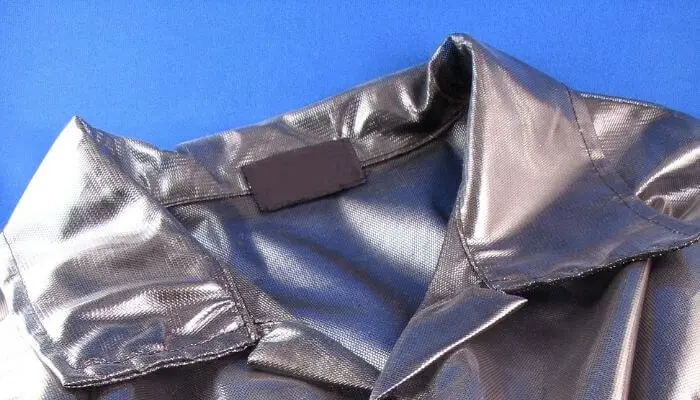Contrary to popular belief, polyester is not waterproof.
It is certainly water-resistant, and the more the thread count increases the more water-resistant it becomes. But, for all intents and purposes, polyester is not waterproof.
What is Polyester?
Polyester is the shortened name of a synthetic (man-made) polymer (plastic) called polyethylene terephthalate.
Ethylene glycol and terephthalic acid are mixed and made into fibers which can then be woven to form a fabric.
Polymers are petroleum-derived compounds that are made up of long strings of repeating subunits
There are two types – the PET (polyethylene terephthalate) and as UPR (unsaturated Polyester).
Despite being made of the same chemicals, UPR is a very different material (it can be used as a resin and a hard plastic) and has different uses to PET.
For the purposes of answering the question is polyester waterproof, we will concentrate on PET.
Before proceeding, it needs to be noted that you should not confuse polyester for nylon.
Polyester and nylon have many similarities as synthetic materials, but they are different materials.
You can also include other synthetics in the mix such as viscose and polythene.
Polyester and Fashion
Polyester can be heated, melted, and cooled without degradation – it is a thermoplastic.
Polyester was a bit of a wonder fabric when it was first introduced but really took off in the 1970s when thanks to its special properties it was used massively by the fashion industry.

It was advertised as “a miracle fibre that can be worn for 68 days straight without ironing, and still look presentable”.
- Flexible and versatile, the characteristics of polyester include:
- Strong and lightweight
- Durability and resistance to many chemicals
- Resistance to stretching and shrinking
- Resistance to abrasions and wrinkling
- Can be easily dyed
- Shape retention
- Quick drying
- Easy to care for
Polyester also has some less-redeeming characteristics which made it fall out of favour – it gained a reputation of being a cheap, shiny fabric and it is slippery and also very prone to static build up.
It is also highly flammable but melts rather than burns. For these reasons, fabric manufacturers began blending polyester with natural fabrics such as cotton, wool and linen.
Polyester blended materials are less waterproof, especially the more modern cotton-poly blends.
Cotton mixes help the clothes to breath, makes them more workable as fabric, and makes it so they burn rather than melt, which is less damaging to human skin.
Mixing polyester and cotton also helps retain the properties of polyester.
Polyester Becomes More Water Resistant As The Thread Count Increases
Polyester material is very water-resistant. It is certainly more water-resistant than cotton or nylon.
The higher the thread count, making the material thicker, then the more water-resistant the material becomes.
If you were to create a balloon with polyester material, and then pour water into it, as you may expect, the thinner the material and the lower the thread count, then the more quickly water will drip through.
Why is Polyester Used in Outdoor Clothing?
The fact that it is pretty durable and very water-resistant makes it an excellent outdoor material.
It also insulates pretty well considering that it doesn’t need a very thick layer to keep the warmth in. Plus, it can take abrasions, scuffs and knocks pretty well.
Many manufacturers of tents and coats will add materials to a polyester blend in order to make it more water-resistant.
In the case of tents, a sealant/water-proofing formula is often applied to the outside to stop water seeping in.
This is especially good for tents since they are rarely put through a washing machine and so sealant coating is maintained for longer.
Plus, the water drips off and dries so quickly that it is almost as if the material is waterproof.
Polyester is relatively tear-resistant and is also pretty UV and mildew resistant.
This means it can handle tougher outdoor situations, and also means that when you take it off and hang it somewhere while still wet, you are less likely to return to a mouldy garment/item.
I Found Water Inside My Tent
A common complaint about polyester tents is that when people wake up in them, the insides are dotted with dewy water.

Though it may seem like the external fog or rain has penetrated, the water you see on the inside is actually condensation from your breath.
You perspire (sweat) and breathe out a total of around 40 grams of water per hour when you sleep.
This means that over the course of a night in a tent, you are adding half a pint of water into the air per person in the tent. The tent walls are cool, so condensation occurs.
The tent walls are also made of polyester, so the water beads up.
That is why it looks like your tent has leaked during the night, when in-fact the water is in your tent because the polyester did its job too well.
Polyester is Very Water Resistant
As you have learned from this article, polyester is a synthetic fibre and is a petroleum product.
Its key benefits are that it is abrasion resistant, dries quickly, is durable, is Lightweight, is relatively strong and is wrinkle resistant.
It is most widely used in clothing, film, trousers, shirts, jackets, hats, blankets, umbrellas and tents.
It also has many industrial and commercial uses, which is probably why it is one of the world’s most popular textiles and will be the most sorely missed when worldwide oil reserves run out and we have to find alternatives.

